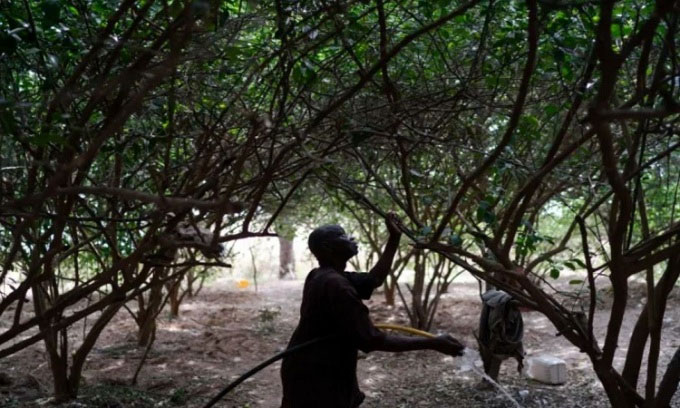African countries aim to plant trees to create a nearly 8,050 km long wall running across the continent, forming a natural barrier to prevent the Sahara Desert from expanding.
The Great Green Wall project began in 2007 with the goal of creating a green belt across the vast Sahel region, from Senegal in the west to Djibouti in the east, by 2030. However, rising temperatures and decreasing rainfall have caused millions of trees to die en masse.

Ibrahima Fall watering his lemon garden in Ndiawagne Fall village, Kebemer, Senegal, on November 5. (Photo: AP)
Efforts to combat desertification continue in Senegal on a smaller scale. At the western end of the planned tree wall, farmer Ibrahima Fall walks in the shade of dozens of lemon trees. Surrounding the garden and the village is a barren, isolated area. The lemon garden provides a refuge from the heat and sandstorms. Outside the low walls of the village, the wind whips up sand into the air, promoting desertification, a process where fertile land gradually turns into desert, often due to drought and deforestation.
African countries have only completed 4% of the initial goal of the Great Green Wall project and need an estimated $43 billion to achieve the remaining objectives. With the likelihood of building the barrier on time appearing very bleak, organizers are shifting focus from planting a large tree wall to smaller, more sustainable projects aimed at preventing desertification, while also improving livelihoods and assisting the most struggling agricultural regions.
“Projects that do not involve the community are sure to fail,” said Diegane Ndiaye, a member of the SOS Sahel organization that supports tree planting programs in Senegal and several other countries along the Sahel. The Sahel is the region situated between the Sahara Desert to the north and the more temperate African savannas to the south. The program focuses on environmental restoration and economic revitalization in villages across the Sahel, according to Ndiaye. With declining rainfall and desert encroachment, this strip of land is highly susceptible to the impacts of climate change.
Along the Atlantic coast of Senegal, casuarina trees stretch from Dakar to the northern city of St. Louis, forming a “windbreak” that protects the beginning of the Great Green Wall. The canopy rises high to block strong winds from the sea. This reforestation project started in the 1970s, but many trees were cut down for wood, and restoration efforts have only recently begun. Locals also plant trees in front of sand dunes near water sources to prevent the dunes from shifting.
Fall planted his lemon garden in 2016 and positioned the crops close to a water source on his land. His lemon garden is among 800 small lemon gardens in six communities within Kebemer. Villagers use the profits from the gardens to replace straw houses with solid cement homes and to purchase additional sheep, goats, and chickens. The village has also installed solar panels to pump water from a communal well, alleviating the community’s concerns about water scarcity in the desert.
The President of the African Development Bank, Akinwumi A. Adesina, emphasized the importance of combating desertification in the Sahel at the United Nations COP26 climate summit and committed $6.5 billion to the Great Green Wall project by 2025.
The latest project in Senegal involves circular gardens known as “tolou keur” in Wolof, which include various crops strategically planted so that larger plants protect smaller ones. The outer ring of the garden features drought-resistant plants such as moringa, sage, papaya, and mango. These plants are arranged so that their roots grow inward to enhance the soil’s water retention capabilities. Senegal has a total of 20 circular gardens, each tailored to the land, culture, and needs of its respective community. Initial results indicate that this garden style is thriving in the area designated for the Great Green Wall.


















































